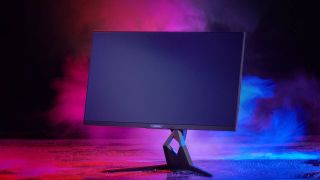Do you really need a 4K monitor?
Is a 4K monitor actually worth it?

These days, especially thanks to Black Friday deals cropping up, it seems like everyone is talking about the best 4K monitors, and for good reason. We've been seeing more content available in 4K, with hundreds (or even thousands) of YouTube videos, not to mention all the streaming services that support the resolution.
But for a display that's either for getting work done or for playing the best PC games, getting a 4K monitor might not actually be worth it. Gamers will likely want a faster refresh rate, and games like Cyberpunk 2077 are notoriously hard to run at high resolution.
And, if most of what you're doing is going through spreadsheets or writing up emails, there's little to gain from such a high resolution. So, with the advent of extremely powerful hardware like the Nvidia GeForce RTX 4090 that promises to deliver a flawless 4K experience no matter what you're using your PC for, it's worth asking if you should jump for a premium 4K monitor, or save some cash and get one of the best 1440p monitors or the best monitors instead.
Let's talk about 4K gaming

If you pay any attention to gaming, you probably know that the PS5 and Xbox Series X are all about 4K gaming, even if those consoles mostly miss the mark when it comes to the actual rendering resolution – they're mostly using methods to upscale the games from a lower resolution.
However, in September 2020 when Nvidia announced the GeForce RTX 3090, the company advertised the graphics card as being able to handle gaming not only in 4K, but in 8K. Since then, Nvidia's RTX 4000 series has delivered on that promise, especially the RTX 4070, 4070 Ti, 4080, and 4090. On the AMD side, we have the AMD Radeon RX 6800 XT, RX 7800 XT, and RX 7900 XTX.
While there are definitely graphics cards out there that can easily handle 4K gaming, most graphics cards on the market simply can't. The GTX 1060 is the second most popular graphics card right now according to the latest Steam Hardware Survey. That card is really just for 1080p gamers, and it's starting to struggle even there – especially in more graphically demanding games.
It's no wonder then, that according to that same hardware survey, only 2.59% of Steam users are using a 4K monitor, with a whopping 59% still using 1080p screens, and 23.14% are using 1440p.
Get daily insight, inspiration and deals in your inbox
Get the hottest deals available in your inbox plus news, reviews, opinion, analysis and more from the TechRadar team.
And that latter resolution is the interesting one, especially when you consider monitors with a high refresh rate. While the best graphics cards can absolutely play most games at 4K around 60 fps, you could be getting an even smoother experience at 1440p.
Creating #content

So, while a 4K monitor doesn't really make much sense for gaming, that doesn't mean that they're totally worthless. Like we've already mentioned, there is a ton of content available at 4K. And while we'll always like watching movies in 4K in our living room on a TV, actually creating that content is an entirely different story.
If you're editing video at 4K, the ability to actually see what you're working on in real time helps immensely when trying to spot small details. In fact, for video editors that regularly work with 4K content, the best 4K monitors might not even be enough anymore. With a 5K or even 8K monitor you'll be able to see the full detail of your project while still having tools be visible in Premiere, Vegas or whatever other program you use to work with video.
But it's not just video. We do a lot of photo editing for our reviews, and we appreciate having a luxe 4K display, as it helps us see exactly what the changes we're making look like, especially when we're editing photos from our DSLR, which shoots in a resolution greater than 4K.
4K monitor for emails?

One of the nicest things about using a 4K display is how clean and crisp everything is, especially text. And, if you have a lot of different things you're working on, you can easily split your display up and still have everything perfectly legible. We know there are several occasions where we'll divide our monitor in quarters, with a couple web browser windows and Slack, especially when there's a lot going on at once.
Especially if you only have space for one monitor it makes sense to get a display that will let you multitask. Grabbing one of the best Ultrawide monitors is even better for this, and can be a lifesaver if you only have so much desk space.
By the same token, though, if you don't need to constantly do ten different things at the same time, there's no reason to grab a 4K display for your PC if you're just going to be doing every day computing work.
For most people that are mostly going to be using their computer for every day web browsing, checking emails and watching some YouTube, a 1080p monitor is still more than enough. Sure, things aren't going to be as crisp, but if you're getting a 24-inch or 27-inch monitor, you probably won't notice the difference, unless you're looking at the two monitors side-by-side.
It's all about the value

The best 4K monitors are getting cheaper every day. It's pretty easy to find a 4K gaming monitor for around $300, like this Asus TUF Gaming VG289Q. And unlike older 4K models that didn't offer the best ergonomics, color gamut, and refresh rate compared to lower resolution monitors, the latest ones are finally catching up in terms of specs. You can get a 4K display that offers incredible performance whether for gaming or for creative-minded projects.
However, as 1080p or 1440p displays have been around for much longer, it's far easier to get a much nicer monitor with those resolutions, that won't mute all the colors in your photos and will have better viewing angles, so you don't have to squint at your screen because you're slightly off to the side.
And, those high refresh rates you'll find in lower-resolution displays aren't just for gamers. Everything you do on your PC is fueled by hundreds of tiny animations, from moving a window around the desktop to just moving your mouse cursor. On a high-refresh display, everything just has a smoothness to it that's hard to describe until you experience it for yourself.
When it comes to value, 4K offers excellence in that field but you'll most likely be spending more for it. Meanwhile, you can have impressive specs in 1440p and especially 1080p monitors for much cheaper pricing, especially when looking for discounted displays during the holiday season.
Jackie Thomas is the Hardware and Buying Guides Editor at IGN. Previously, she was TechRadar's US computing editor. She is fat, queer and extremely online. Computers are the devil, but she just happens to be a satanist. If you need to know anything about computing components, PC gaming or the best laptop on the market, don't be afraid to drop her a line on Twitter or through email.
- Allisa JamesComputing Staff Writer

